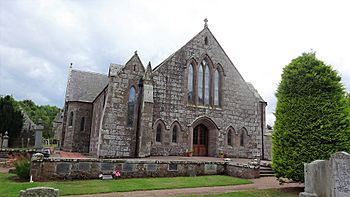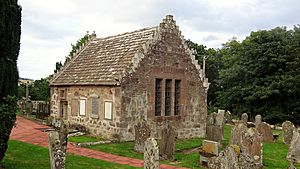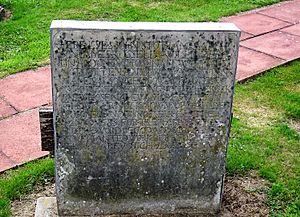Dunnottar Parish Church facts for kids
Quick facts for kids Dunnottar Parish Church |
|
|---|---|
| Carronside Parish Church | |
 |
|
| 56°57′28″N 2°13′37″W / 56.9578°N 2.2270°W | |
| Denomination | Church of Scotland |
| Churchmanship | Reformed |
| Membership | 742 |
| Website | https://www.carronsidechurch.net/ |
| Administration | |
| Parish | Carronside Church |
| Presbytery | Presbytery of Kincardine and Deeside |
Dunnottar Parish Church is a special church in Stonehaven, Scotland. It's part of the Church of Scotland. In 2020, this church joined with another local church, South Parish Church, to create a new church called Carronside Church of Scotland. Reverend Sarah Smith became the minister here on June 3, 2021.
Contents
Where is Dunnottar Church Located?
The church building is in Dunnottar woods, Stonehaven. It sits high up near the Carron water. It's on the edge of Stonehaven, about a 20-minute walk from the town center. Dunnottar Castle is also nearby, about one and a half miles to the south-east. The minister's house, called the manse, is right across the road.
Dunnottar Parish also owns St Bridget's hall. This hall was built in 1887. It was made to be a missionary church for the older part of Stonehaven. In the past, morning services were held at Dunnottar Church. Evening services took place at St Bridget's. Today, St Bridget's hall is used for evening communion and church meetings. Community groups also use it.
In 2021, a new path was made. This path crosses Toucks Burn, a small stream. It connects the church to the nearby Dunnottar Park housing area.
The Church Building's History
The church building you see today was rebuilt in 1852. It was made bigger in 1869. In 1903, it had a major reconstruction. This made it much larger. A nave (the main part of the church) and a chancel (the area around the altar) were added. This changed the building from a rectangle to a cross shape.
Recently, the church was renovated again. These changes made it easier for everyone to access. They also added a new room for different activities.
The Church Bell
The church bell was made in 1793 by Andrew Lawson. He was the last bell maker from Old Aberdeen. People think this bell is one of his best works. F.C. Eeles wrote about it in his book Church bells of Kincardineshire. He said the bell has very old designs. These designs show how bell-making traditions were passed down.
The Marischal Aisle
The Marischal Aisle is a special building in the church grounds. It is now used as a mausoleum (a building for tombs). It was first built in 1582 by George Keith, 5th Earl Marischal. He was the 5th Earl Marischal of Scotland. He also founded Marischal College in Aberdeen.
The Covenanters Stone
In the churchyard, you can find the Covenanters Stone. This stone reminds us of the Covenanters. These were people who were imprisoned in nearby Dunnottar Castle. The stone is said to have inspired Sir Walter Scott's novel Old Mortality. In the story, a character named Robert Patterson carefully restores the lettering on the Covenanters Stone.
The stone has an inscription that tells a sad story. It lists the names of people who died as prisoners in Dunnottar Castle in 1685. They were imprisoned for their beliefs and for supporting Scotland's Covenanted Work of Reformation. The stone also mentions a verse from the Bible, Revelation chapter 12, verse 11.
More to Explore




